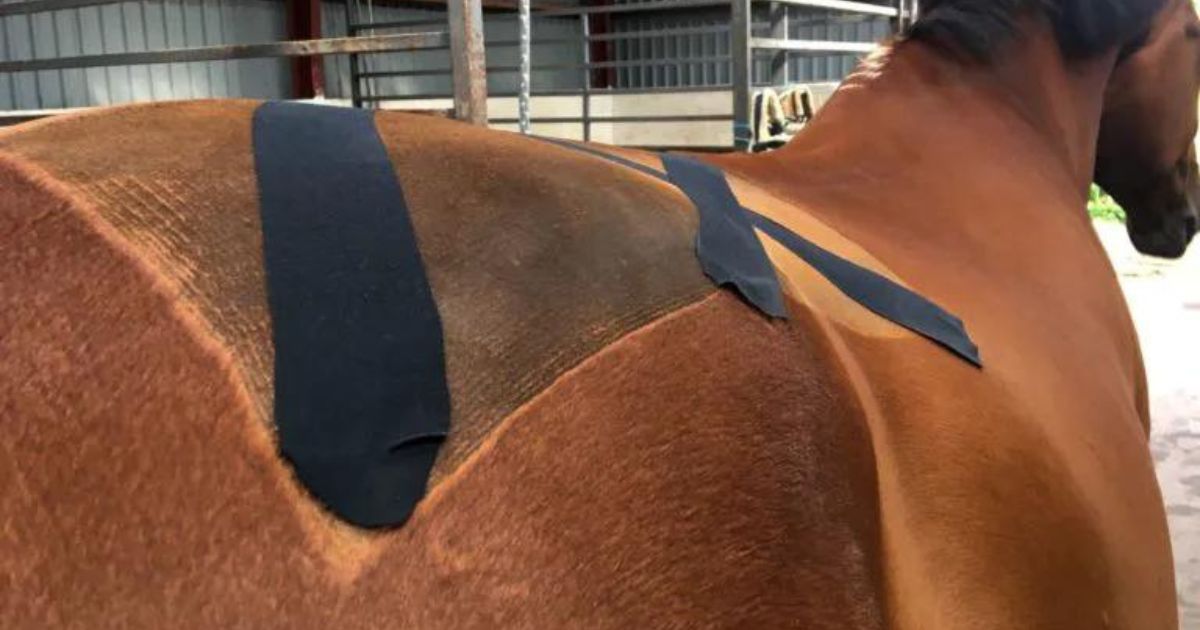Menu

Alternative therapies are becoming increasingly popular, not just for humans but also for our four-legged friends, and horses are no exception. Osteopathy, craniosacral therapy, and laser therapy are now well-known treatment methods. But what about this so-called kinesiology taping, or simply kinesiotaping? Is it merely a magical illusion? We provide a thorough and critical answer here.
Kinesiotaping is commonly used in hospitals and by physiotherapists to treat athletes, the elderly, and others with injuries, promoting the body's natural healing process and alleviating muscle and joint pain, cramps, and stiffness. Despite sounding a bit like magic, it is not a “miracle plaster”. Instead, it's based on a quite sensible and highly recognized technique.
Both the tape and the technique behind it were developed by a Japanese chiropractor, designed to enhance the body's natural self-healing capabilities. The tape, which is applied to the skin - at least on humans - can remain in place for up to a full week and is reportedly water-resistant.
The tape, made of cotton and acrylic, is elastic in both directions. When stretched and then contracted, it acts like an extra layer of skin, pulling the underlying tissue together, thus offering pain relief and increased flexibility.
Read also: Got a handle on the shoes? - Nailed shoes
The same principles apply to horses. However, taping a horse's coat is quite different from taping human skin. As a result, special versions of the tape have been developed for horses. For example, Back on Track produces a tape containing ceramic particles, claimed to be suitable for horses, dogs, and humans, though this is met with some skepticism. Horse physiotherapist Katja Bredlau-Morich recommends using the Equi-Tape brand. It's a stronger, more adhesive kinesiotape specifically for horses. There's also an even more robust option, Rock Tape. However, having tested regular kinesiotape, commonly used by athletes, we at Malgré Tout conclude that it is not sufficient for horses. While it is easy to apply, it falls off just as quickly. So, you should certainly go with Katja's recommendation.
Applying kinesiotape on a horse requires a deep understanding of its anatomy. In her book "Kinesiology Taping for Horses," Katja provides a comprehensive guide for horse owners on using kinesiotape. Unfortunately, she only partially conveys the necessary knowledge about horse anatomy for proper tape application. Setting that aside, let's take a closer look at what she writes.
Katja categorizes her techniques into taping horse muscles, connective tissue (fascia), lymphatics, scars, hematomas, and tendons. She also covers the use of taping for decompression and stabilization. We can't replicate everything she writes, but we'll briefly explain how she suggests taping horse muscles.
Before taping a muscle, one must accurately know where it attaches to the bone. This information can typically be found in books or, better yet, by consulting a veterinarian.
Before starting with tape and scissors, the muscle should be activated, ideally massaged. For example, to tape a horse's triceps, the muscle group should be stretched by extending the horse's foreleg as far as possible, holding the stretch for about 30 seconds if possible.
After this, the tape edges are rounded off to prevent sticking out. The tape (still on the roll) is then applied in a 5-7 cm piece at the point where the muscle attaches to the bone, without stretching this part. Slowly peel off the backing, rubbing it in the direction of the hair. This piece serves primarily as an anchor.
Read also: New horse? 6 things that can ensure you make the right choice
Only then should you start pulling the tape. Hold it firmly at the attachment point and stretch it while sliding a hand over the stretched tape in the hair's direction to secure it. When you reach the point where the muscle attaches to another bone, release the tension and let 5-7 cm sit as an anchor.
Finally, cut the tape from the roll, round the edges, and rub the anchor into the coat. The stretched part of the tape should start to contract and form wrinkles. If it does and stays in place, the application is correct.
Here is a video by an American veterinarian demonstrating how to use the tape to reduce muscle pain in horses. Notice how she follows the direction of the hair and leaves the first and last parts of the tape unstretched.
We believe that kinesiotaping can be beneficial for our horses. However, it must be done correctly and with tape that is specifically designed for this purpose. Even though one can learn a lot and it's fun to experiment on one's own, we must accept that we "ordinary horse people" will never be able to tape our horses as precisely and effectively as a professional. Isn't that precisely why we have our veterinarians, horse physiotherapists, and so on? If done by a trained veterinarian, we believe it's not just hocus pocus, but rather a treatment method that truly deserves widespread adoption. It should be performed by people who really know what they're doing. What do you think?
Sources:
Bredlau-Morich, Katja (2017). "Kinesiology Taping for Horses." USA: Horse and Rider Books.